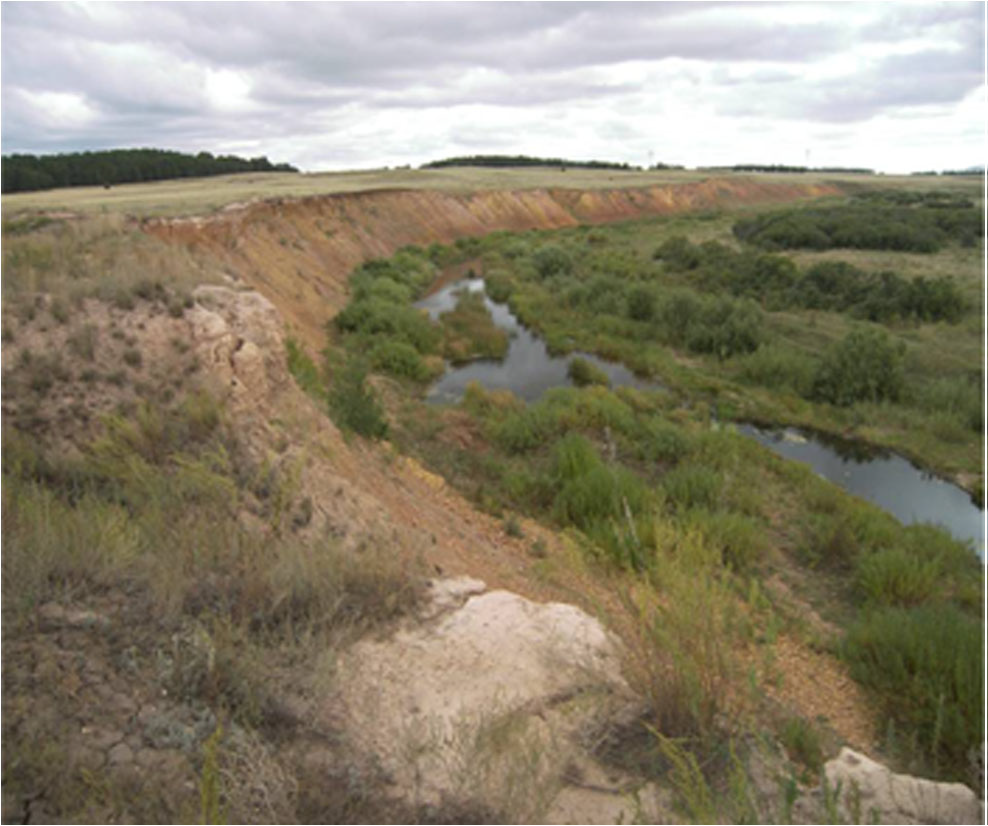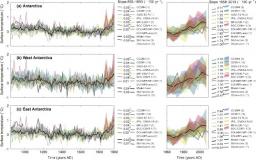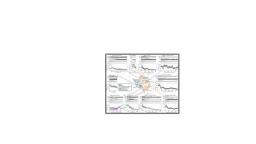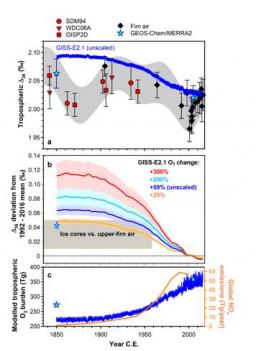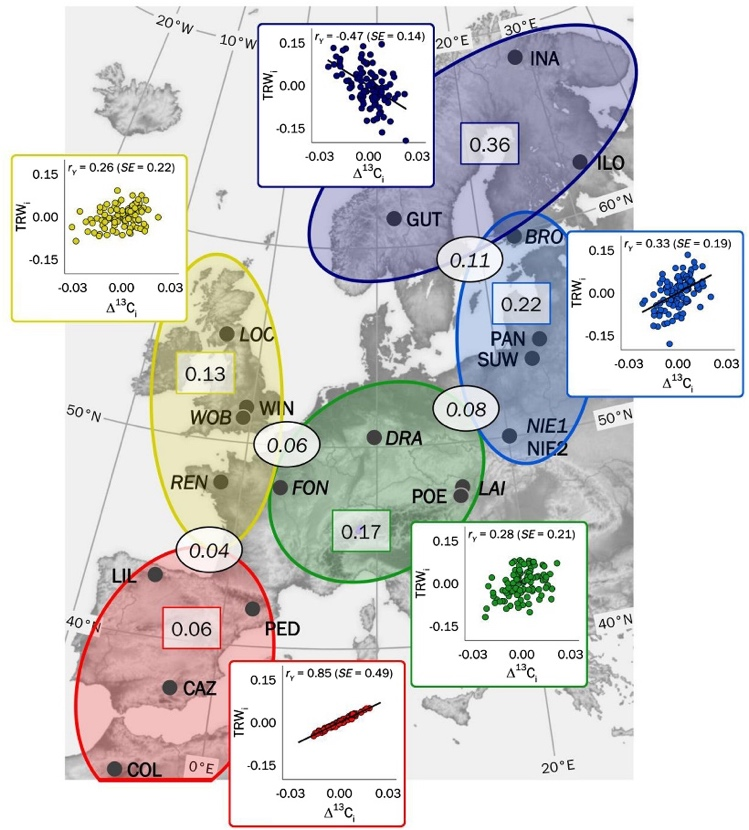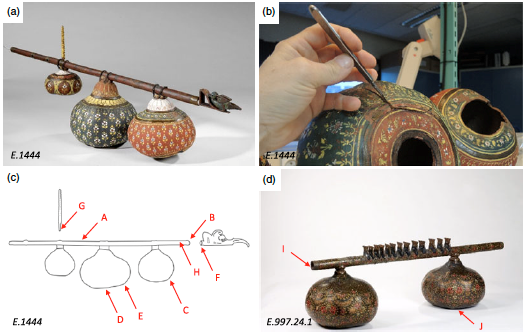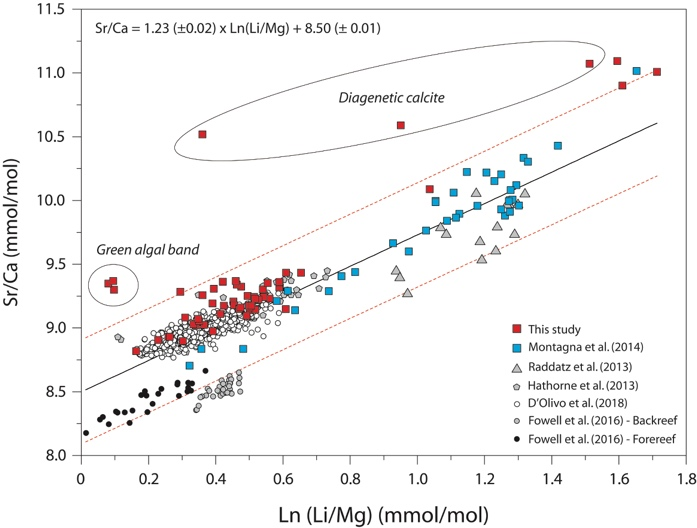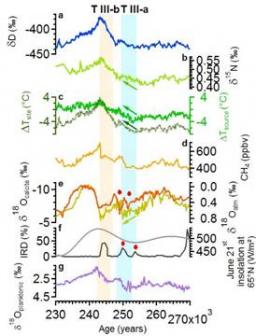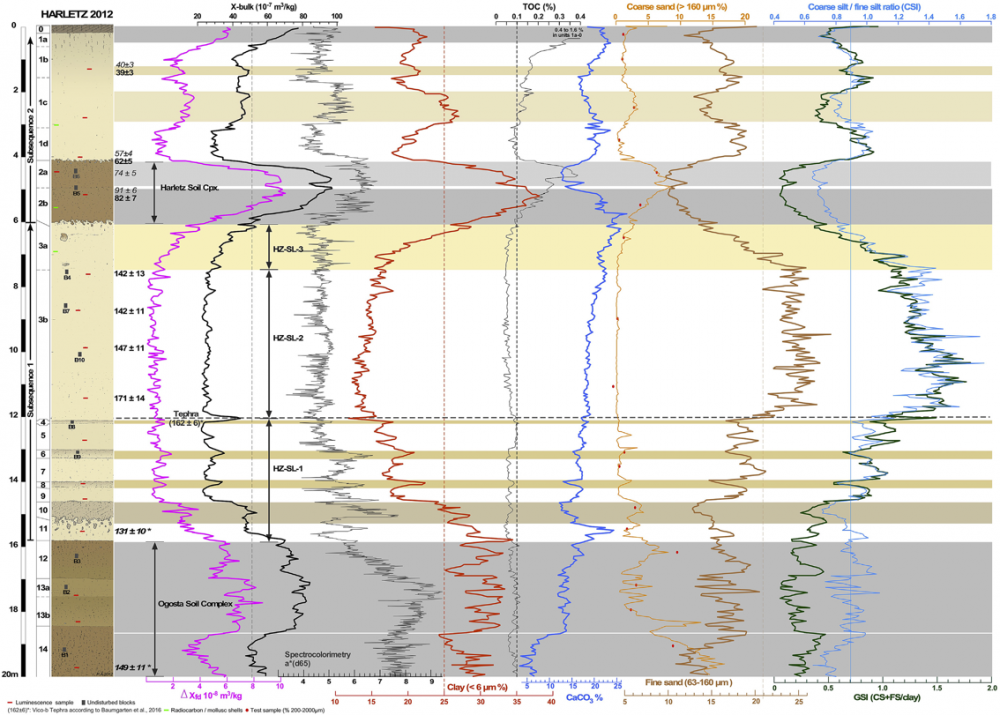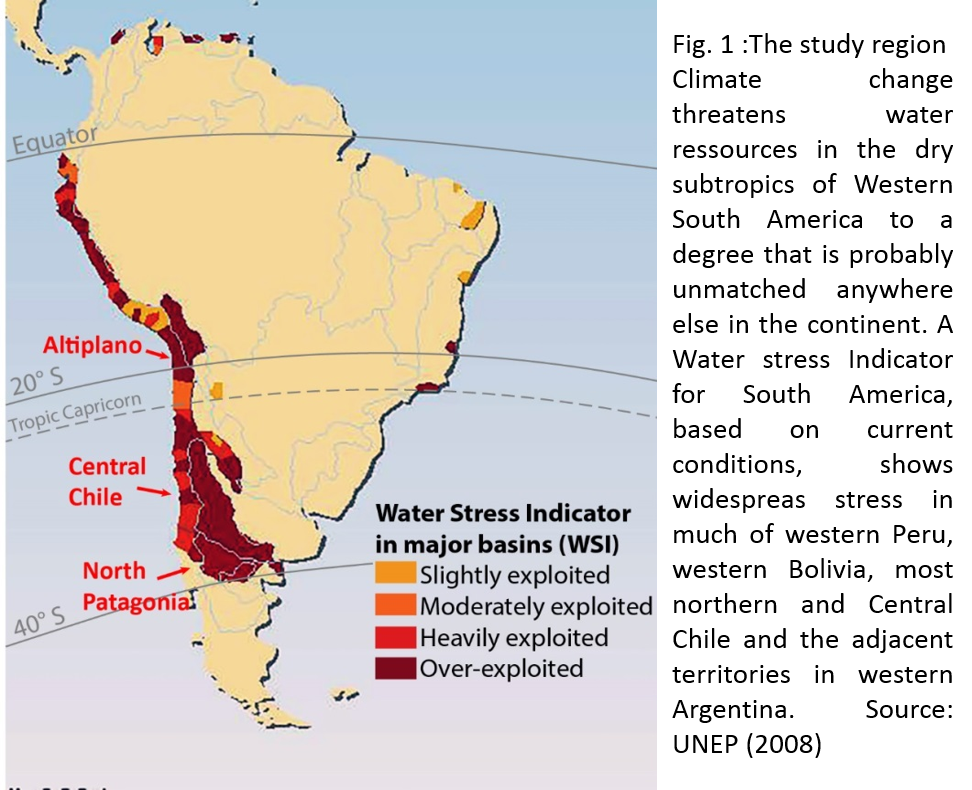Faits marquants 2019
En France, des équipes de recherche, reconnues au niveau international, travaillent sur les climats passés, leur impact sur les écosystèmes et la modélisation des climats.
La suite est à lire sur le site de Science et Avenir
Référence : Sciences et Avenir du 29 novembre 2019. Avec intervention de V. Daux, A. Orsi, C. Hatté, M. Kageyama D. Roche.
Cet article présente les premiers résultats des fouilles du site de Botai (Kazakhstan). Il s'agit d'un campement occupé par des éleveurs de chevaux des steppes d'Asie Centrale durant l'Énéolithique. Les datations au radiocarbone indiquent deux occupations distinctes : entre 3550 et 2700 cal BC puis vers 2000 cal BC. Les résultats d'archéobotanique, fondés sur les vestiges macrobotaniques et sur l'analyse de biomarqueurs moléculaires indiquent que ces populations n'appartenaient pas à un réseau complexe d'échanges de céréales qui ne constituaient pas, par ailleurs, l'alimentation principale. La présence de miliacine suggère que ces populations ont pu cultiver le millet, peut-être après la période d'occupation principale du site.
Référence : Motuzaite-Matuzeviciute G., Lightfoot E., Liu X., Jacob J., Outram A.K., Zaibert V.F., S. Zakharov S., Jones M.K., 2019. Archaeobotanical investigations at the earliest horse herder site of Botai in Kazakhstan. Journal of Archaeological and Anthropological Sciences 11, 6243. Doi:10.1007/s12520-019-00924-2
The Antarctic temperature changes over the past millennia remain more uncertain than in many other continental regions. This has several origins: (1) the number of high-resolution ice cores is small, in particular on the East Antarctic plateau and in some coastal areas in East Antarctica; (2) the short and spatially sparse instrumental records limit the calibration period for reconstructions and the assessment of the methodologies; (3) the link between isotope records from ice cores and local climate is usually complex and dependent on the spatial scales and timescales investigated. Here, we use climate model results, pseudoproxy experiments and data assimilation experiments to assess the potential for reconstructing the Antarctic temperature over the last 2 millennia based on a new database of stable oxygen isotopes in ice cores compiled in the framework of Antarctica2k (Stenni et al., 2017). The well-known covariance between δ18O and temperature is reproduced in the two isotope-enabled models used (ECHAM5/MPI-OM and ECHAM5-wiso), but is generally weak over the different Antarctic regions, limiting the skill of the reconstructions. Furthermore, the strength of the link displays large variations over the past millennium, further affecting the potential skill of temperature reconstructions based on statistical methods which rely on the assumption that the last decades are a good estimate for longer temperature reconstructions. Using a data assimilation technique allows, in theory, for changes in the δ18O–temperature link through time and space to be taken into account. Pseudoproxy experiments confirm the benefits of using data assimilation methods instead of statistical methods that provide reconstructions with unrealistic variances in some Antarctic subregions. They also confirm that the relatively weak link between both variables leads to a limited potential for reconstructing temperature based on δ18O. However, the reconstruction skill is higher and more uniform among reconstruction methods when the reconstruction target is the Antarctic as a whole rather than smaller Antarctic subregions. This consistency between the methods at the large scale is also observed when reconstructing temperature based on the real δ18O regional composites of Stenni et al. (2017). In this case, temperature reconstructions based on data assimilation confirm the long-term cooling over Antarctica during the last millennium, and the later onset of anthropogenic warming compared with the simulations without data assimilation, which is especially visible in West Antarctica. Data assimilation also allows for models and direct observations to be reconciled by reproducing the east–west contrast in the recent temperature trends. This recent warming pattern is likely mostly driven by internal variability given the large spread of individual Paleoclimate Modelling Intercomparison Project (PMIP)/Coupled Model Intercomparison Project (CMIP) model realizations in simulating it. As in the pseudoproxy framework, the reconstruction methods perform differently at the subregional scale, especially in terms of the variance of the time series produced. While the potential benefits of using a data assimilation method instead of a statistical method have been highlighted in a pseudoproxy framework, the instrumental series are too short to confirm this in a realistic setup.
Authors :François Klein, Nerilie J. Abram, Mark A. J. Curran, Hugues Goosse, Sentia Goursaud,Valérie Masson-Delmotte, Andrew Moy, Raphael Neukom, Anais Orsi, Jesper Sjolte, Nathan Steiger, Barbara Stenni, and Martin Werner.
Ref. : Clim. Past, 15, 661-684, 2019 https://doi.org/10.5194/cp-15-661-2019
The Antarctic ice sheet mass balance is a major component of the sea level budget and results from the difference of two fluxes of a similar magnitude: ice flow discharging in the ocean and net snow accumulation on the ice sheet surface, i.e. the surface mass balance (SMB). Separately modelling ice dynamics and SMB is the only way to project future trends. In addition, mass balance studies frequently use regional climate models (RCMs) outputs as an alternative to observed fields because SMB observations are particularly scarce on the ice sheet.
Here we evaluate new simulations of the polar RCM MAR forced by three reanalyses, ERA-Interim, JRA-55, and MERRA-2, for the period 1979–2015, and we compare MAR results to the last outputs of the RCM RACMO2 forced by ERA-Interim. We show that MAR and RACMO2 perform similarly well in simulating coast-to-plateau SMB gradients, and we find no significant differences in their simulated SMB when integrated over the ice sheet or its major basins. More importantly, we outline and quantify missing or underestimated processes in both RCMs. Along stake transects, we show that both models accumulate too much snow on crests, and not enough snow in valleys, as a result of drifting snow transport fluxes not included in MAR and probably underestimated in RACMO2 by a factor of 3. Our results tend to confirm that drifting snow transport and sublimation fluxes are much larger than previous model-based estimates and need to be better resolved and constrained in climate models. Sublimation of precipitating particles in low-level atmospheric layers is responsible for the significantly lower snowfall rates in MAR than in RACMO2 in katabatic channels at the ice sheet margins. Atmospheric sublimation in MAR represents 363 Gt yr−1 over the grounded ice sheet for the year 2015, which is 16 % of the simulated snowfall loaded at the ground. This estimate is consistent with a recent study based on precipitation radar observations and is more than twice as much as simulated in RACMO2 because of different time residence of precipitating particles in the atmosphere. The remaining spatial differences in snowfall are attributed to differences in advection of precipitation with snowfall particles being likely advected too far inland in MAR.
Authors : C. Agosta, C. Amory, C. Kittel, A. Orsi, V. Favier, H. Gallée, M.R. van den Broeke, J.T.M. Lenaerts, J.M. van Wessem, W.J. van de Berg, and X. Fettweis.
Tropospheric ozone (O3) is key component of air pollution and an important anthropogenic greenhouse gas. During the 20th century, proliferation of the internal combustion engine, rapid industrialization, and land-use change led to a global-scale increase in its concentrations, but the magnitude of this increase is not known. Atmospheric chemistry models typically predict an increase in the tropospheric O3 burden of less than 50% since 1900,1,2 while direct measurements made in the late 19th century imply that surface O3 mixing ratios increased by much more, up to 300%3-5. Improvements in model chemistry have reduced disparities somewhat6,7, but the accuracy and diagnostic power of the measurements remains controversial8. Here, we place limits on the 20th-century increase in tropospheric O3 using a record of the clumped-isotope composition of molecular oxygen (18O18O in O2) trapped in polar firn and ice. We find that proportions of 18O18O in O2 decreased by 0.03 ± 0.02‰ below their 1590 – 1958 C.E. mean during the second half of the 20th century, implying that tropospheric O3 increased less than 40% during that time. These results corroborate model predictions of global-scale increases in surface pollution and vegetative stress caused by increasing anthropogenic emissions of O3 precursors1,2,9. The radiative forcing due to tropospheric O3 since 1850 C.E. is likely less than +0.4 W m-2, placing limits on the impact of air-quality regulation as a global warming mitigation strategy.
Authors : Laurence Y. Yeung, Lee. T. Murray, Patricia Martinerie, Emmanuel Witrant, Huanting Hu, Asmita Banerjee, Anaïs Orsi, and Jérôme Chappellaz.
Ref. : Nature, vol. 570, no 7760, p. 224, 2019
The modern antiquities market uses radiocarbon (14C) dating to screen for forged objects. Although this fact shows the potential and power of the method, the circumstances where it is applied can be questionable and call for our attention. Here we present an outline of a call to radiocarbon laboratories for due diligence and best practice approaches to the analysis of antique objects requested by non-research clients.
Protection of cultural heritage is considered one of the most important national and international goals. Each nation has the right to protect their past and present cultural goods, both tangible and intangible. The fact that international involvement is needed has been recognized since the early 20th century. The need for protection of culture is essential for building peace as it was stated by founders of the UNESCO when it was established in Nov.– Dec. 1945. In 1970 a UNESCO Convention on the protection of cultural heritage was adopted and ratified by most of the countries. Concerns of the post-WWII era were with the destruction of cultural heritage that wars and crises impose on whole communities (Gerstenblith 2008).
The present-day antiquities trade is operating in a world that is far from being free of conflicts and wars. It is a most striking fact that the remains of old cultures and civilizations are located and endangered by conflicts and looting. Illicit trade of antique objects is driven by the demand for antiquities in countries outside of conflicts. Huysecom et al. (2017) have shown that on the part of buyer this demand is accompanied by the need for a secure investment. Whenever possible, antiquities on the market are tested using scientific methods such as thermoluminescence (TL) and radiocarbon (14C) dating. However, the use of the scientific techniques and involvement in authentication appears questionable and raises ethical issues similar to those faced by conservators (Sease 1998).
The radiocarbon community has recognized this problem and is committed to following due diligence protocols, which will help to minimize the involvement of laboratories in providing data for illegally displaced antiquities.
Here, we propose the first measures that can help to minimize access of the illicit market to radiocarbon analysis and to prevent misuse of 14C ages in promotion of illicit trade and looting. This would also protect the radiocarbon laboratories. These procedures are proposed to be applied when the analysis is requested by private persons or for-profit organizations such as auction houses, antiquity dealers, and private collections (sometimes private museums).
Référence : Hajdas I., Jull A.J.T., …, Hatté C., ….Beck L., …., 2019. Radiocarbon dating and the protection of cultural heritage. Radiocarbon 61, 1133-1134. Doi:10.107/RDC.2019.100
The aim of this paper was to decipher Europe‐wide spatio‐temporal patterns of forest growth dynamics and their associations with carbon isotope fractionation processes inferred from tree rings as modulated by climate warming.
Location: Europe and North Africa (30‒70° N, 10° W‒35° E). Time period: 1901‒2003. Major taxa studied: Temperate and Euro‐Siberian trees.
We characterize changes in the relationship between tree growth and carbon isotope fractionation over the 20th century using a European network consisting of 20 site chronologies. Using indexed tree‐ring widths (TRWi), we assess shifts in the temporal coherence of radial growth across sites (synchrony) for five forest ecosystems (Atlantic, boreal, cold continental, Mediterranean and temperate). We also examine whether TRWi shows variable coupling with leaf‐level gas exchange, inferred from indexed carbon isotope discrimination of tree‐ring cellulose (Δ13Ci).
We find spatial autocorrelation for TRWi and Δ13Ci extending over a maximum of 1,000 km among forest stands. However, growth synchrony is not uniform across Europe, but increases along a latitudinal gradient concurrent with decreasing temperature and evapotranspiration. Latitudinal relationships between TRWi and Δ13Ci (changing from negative to positive southwards) point to drought impairing carbon uptake via stomatal regulation for water saving occurring at forests below 60° N in continental Europe. An increase in forest growth synchrony over the 20th century together with increasingly positive relationships between TRWi and Δ13Ci indicate intensifying impacts of drought on tree performance. These effects are noticeable in drought‐prone biomes (Mediterranean, temperate and cold continental).
At the turn of this century, convergence in growth synchrony across European forest ecosystems is coupled with coordinated warming‐induced effects of drought on leaf physiology and tree growth spreading northwards. Such a tendency towards exacerbated moisture‐sensitive growth and physiology could override positive effects of enhanced leaf intercellular CO2 concentrations, possibly resulting in Europe‐wide declines of forest carbon gain in the coming decades.
Référence : Shestakova T.A. et al., including Daux V., 2019. Spatiotemporal patterns of tree growth as related to carbon isotope fractionation in European forests under changing climate. Glob. Ecology Biogeog. 28, 1295-1309. Doi: 10.1111/geb.1293
Dans son numéro d'août 2019, la revue Ca m'intéresse relate la découverte des Mario Wannier et de ses co-auteurs. Dans les sables des plages d'Hiroshima, les auteurs ont identifié des particules exotiques dont ils attribuent l'origine aux matériaux produits par l'explosion de la bombe nucléaire sur la ville d'Hiroshima le 6 août 1945. Jérémy Jacob, chercheur CNRS au Laboratoire des Sciences du Climat et de l'Environnement et spécialiste de l'Anthropocène, a été sollicité pour donner son avis sur cette découverte originale.
Références :
Nathalie Picard (avec intervention de Jérémy Jacob). Ça m'intéresse, Août 2019
Wannier, M.M.A., de Urreiztieta, M., Wenk, H.R., Stand, C.V., Tamura, N., Yuec, B., 2019. Fallout melt debris and aerodynamically-shaped glasses in beach sands of Hiroshima Bay, Japan. Anthropocene 25. Doi:10.1016/j.ancene.2019.100196
Although radiocarbon (14C) dating is commonly used for archeological music instruments, little research has been conducted on modern instruments (16th–19th centuries). New technology, based on the Mini Carbon Dating System (MICADAS), enables some of the recurring challenges (e.g. sampling size) to be circumvented and paves the way for a new field of investigation. We here address the Indian instrumentarium, about which very little is known. We investigate the making and the restoration phases of two vina, a kinnari vina (E.1444), and a rudra vina or bin (E.997.24.1). By comparing 14C measurements made on several samplings of the instruments’ elements with museological information, we were able to overcome the limits of the calibration curve on the historical times that might yield for several equiprobable interval of ages for a unique 14C activity measurement. We were here able to specify a unique calibrated interval of ages [1666 AD – 1690 AD] for the kinnari vina, with a restoration phase [1678 AD – 1766 AD] for the upper nut. The bin is likely attributed to the [1650 AD – 1683 AD] interval.
Référence : Durier M.-G., Bruguière P., Hatté C., Vaiedelich S., Gauthier C., Thil F., Tisnérat-Laborde N., 2019. Radiocarbon dating of legacy music instrument collections : example of traditional Indian vina from the Musée de la Musique, Paris. Radiocarbon 61(5), 1357-1366. Doi : 10.107/RDC.2019.71
Projet DATIM – DIM Patrimoine, Ile de France
The coral Li/Mg temperature proxy is revisited through an in-depth trace element analysis of scleractinians collected live from tropical to polar environments. The dataset consists of Li/Ca, Mg/Ca, Sr/Ca and Li/Mg ratios of 64 coral specimens belonging to 8 different taxa, including both reef-building zooxanthellate and cold-water non-zooxanthellate species, from a wide range of water temperature (-1 to 29.5°C), salinity (34.71 to 38.61,) and depth (3 to 670m).
Our results showed that the reliability of the Li/Mg temperature proxy is strongly limited by the organic matter associated with the coral skeleton, which is most evident within the green bands observed in tropical corals. Organic-rich bands can double the Mg content otherwise present in the skeleton, which may ultimately lead to a temperature overestimation exceeding 15°C. We found that this bias can be overcome by the treatment of coral skeletons with a specific oxidizing cleaning protocol. We also detected the presence of calcite deposits within the aragonite skeleton of some Antarctic living coral specimens, which strongly affects the robustness of the Li/Mg proxy given its temperature sensitivity of ~1.5°C/1% calcite. Therefore, to obtain reliable reconstructions a correction needs to be applied when organic matter and/or calcite contamination is present.
The integrated results across a wide temperature range, from extreme cold to tropical shallow waters, yield to an overall precision for the Li/Mg-temperature proxy of ±1.0°C, with slight differences on the uncertainties depending on the environment: ±0.9°C, ±1.5°C and ±2.6°C for deep, intermediate, and tropical shallow water corals, respectively. However, the uncertainty for tropical corals can be reduced to ±0.6°C if a Li/Mg and Sr/Ca multi-regression approach is applied.
Référence : Cuny-Guirriec K., Douville E., Reynaud S., Allemand D., Bordier L., Canesi M., Mazzoli C., Taviani M., Canese S., McCulloch M., Trotter J., Rico-Esenaro S.D., Sanchez-Cabeza J.A., Ruiz-Fernandez A.C., Carricart-Ganivet J.P., Scoot P.M., Sadekov A., Montagna P., 2019. Coral Li/Mg thermometry: caveats and constraints. Chemical Geology, 523, 167-178. Doi: 10.1016/j.chemgeo.2019.03.038
Each glacial – interglacial transition of the Quaternary occurs in a different orbital context leading to various timing for the deglaciation and sequence of high vs low latitudes events. Termination 3, 250 kiloyears before present (ka), is an unusual deglaciation in the context of the last 9 deglaciations recorded in the old EPICA Dome C (EDC) Antarctic ice core: it exhibits a three–phase sequence, two warming phases separated by a small cooling, the last phase suggesting a particularly rapid temperature increase. We present here new high resolution d15N and deuterium excess (d–excess) data from the EDC ice core to provide a detailed temperature change estimate during this termination. Then, we combined the dD and d18O to discuss the relationship between high and low latitude changes through the d-excess. We also provide the high vs low latitude sequence of events over this deglaciation without chronological uncertainty using low latitude ice core proxies. In agreement with previous studies based on speleothem analyses, we show that the first phase of Termination 3 (256 to 249 ka) is associated with small Heinrich like events linked to changes in ITCZ position, monsoon activity and teleconnections with Antarctica. In a context of minimum Northern Hemisphere insolation, this leads to a rather strong Antarctic warming, as observed in the d15N record in contrast to the relatively small dD increase. The second warming phase occurs during the rise of the Northern hemisphere insolation, with a large Heinrich like event leading to the characteristic Antarctic warming observed in the d15N and dD increase as for the more recent terminations.
Auteurs : C. Bréant, A. Landais, A. Orsi, P. Martinerie, T. Extier, F. Prié, V. Masson-Delmotte, J. Jouzel, M. Leuenberger
Ref. : Quaternary Science Reviews, 211, 156-165, 2019
Projet/financement: ERC Combiniso, LEFE NEVE/CLIMAT
While numerous high-resolution studies concerning Last Glacial aeolian sequences are available for Europe, the approach of the penultimate glacial in this geographical area is still poorly developed. In order to bridge this gap, this study focuses on the Bulgarian sequence of Harletz, along the Danube River, where extremely high sedimentation rates allow the depiction of high-resolution signals during MIS 6. At Harletz in NW Bulgaria on the western bank of the Ogosta River (tributary of the Danube) a 20m thick loess-palaeosols section was cleaned and sampled for a multi-disciplinary study and detailed pedostratigraphic approach. High-resolution continuous bulk sampling (5 cm) was carried out to characterise sedimentary grain size, magnetic properties (including magnetic susceptibility and its frequency dependence), colour reflectance (1 cm), and organic carbon. Geochronological control is based on 16 samples collected for OSL and MET-pIRIR dating. Using a cyclo-stratigraphic approach of the sequence combined with dating constraints provided by both MET-pIRIR dates and the age of a tephra layer occurring at a depth of 12m within the main loess unit, we can demonstrate that the Harletz section exhibits a 10m thick Late Saalian (Marine Isotope Stage 6, MIS 6) loess accumulation unique in Europe. The lower part of the main loess unit is 4m thick and overlies a basal brown soil complex allocated to MIS 7, which includes an exceptionally thick (4 m) and detailed succession of loess and four incipient soil horizons never described in European loess until now.
Référence : Antoine P., Lagroix F., Jordanova D., Jordanova N., Lomax J., Fuchs M., Debret M., Rousseau D.-D., Hatté C., Gauthier C., Moine O., Taylor S.N., Till J.L., Coutard S., 2019. A remarkable Late Saalian (MIS 6) loess (dust) accumulation in the Lower Danube at Harletz (Bulgaria). Quaternary Science Reviews 2017, 80-100. Doi : 10.1016/j.quascirev.2019.01.005
Thèse de Marie-Gabrielle Durier (2019-2021), sous la direction de C. Hatté et S. Vaiedelich (Musée de la Muisque)
Fondation PATRIMA
Le présent sujet de thèse ambitionne de lever les verrous scientifiques liés au positionnement chronologique de l’instrument de musique en ajoutant la datation 14C à la palette d'approches classiquement utilisées et souvent insuffisantes. Au-delà de la poursuite de la construction d’une histoire de l’usage musical et des pratiques d’entretiens, de réparation ou de restaurations qui sont adressées à l’instrument de musique, elles consolideront l’émergence de concerts historiquement documentés. La géochimie (13C et Sr principalement) apportera des éléments sur les sources des matériaux utilisés.
L’originalité du projet réside dans l’implication de la muséologie, de la caractérisation des matériaux, de la chimie, de la mesure physique et des statistiques bayésiennes. L’apport espéré est donc à la fois méthodologique et expérimental. Le corpus d’instruments sur lesquels seront pratiqués les travaux, sera sélectionné au sein de la collection nationale du Musée de la musique. Ils se composent principalement de deux corpus, les archets anciens, d’une part, les petits instruments (violons et assimilés, luths, guitares.) choisis au regard de l’importante période d’usage dont ils témoignent et le nombre conséquent d’interventions de restaurations qui en sont la conséquence d’autre part. On espère enfin, par le développement d’une nouvelle méthodologie favoriser un intérêt futur de cette approche pour d’autres domaines du patrimoine culturel tel que celui du mobilier.
More frequent droughts, compared to the historical period, have been recorded during the past 30-40 years in subtropical western South America (SWSA; Fig. 1). Drought has a more direct and immediate impact on humans and ecosystems than temperature changes, but modelling of future hydroclimatic changes is problematic and current climate models have large deficiencies in simulating such variability.
Subtropical climate is largely related to the downward branch of the Hadley Circulation (HC). The descending arm of the HC circulation can be considered the “edge of the tropics”. During recent decades, the HC has expanded towards the poles likely in response to anthropogenic global changes, shifting rainfall patterns and broadening the subtropical dry zones, especially in the Southern Hemisphere (SH). Over the last 40 years, this expansion has been estimated to be 1-3° latitude in each hemisphere. These trends in HC expansion are projected to continue through the 21st century. However, the underlying mechanisms of this phenomenon are not well known nor the magnitude of this long-term change. Indeed, several relevant issues, such as the fraction of HC expansion, the causes of the HC broadening (natural, anthropogenic or both), the variability of HC expansion-contraction fluctuations in the past, and the future expansion rates of the subtropical deserts, need to be investigated. The knowledge gaps are partially ascribed to the shortness of observational records documenting changes in large-scale tropical-extratropical atmospheric circulation.
In this context, the overarching aim of the THEMES project is to build a multi-century perspective of HC dynamics using tree-ring records along the America cordillera sector of the SH, extending the analysis of large-scale atmospheric teleconnections beyond the short record provided by instrumental data. The specific objectives are to: (1) Update and develop new tree-ring records along the Andes extending from the outer tropics in the Altiplano (17-23°S), via Central Chile (32-36°S), to northern Patagonia (37-45°S). In addition to traditional ring-width measurements, state-of-the-art techniques in dendroclimatology will be used to develop isotopic and Blue Intensity annual records; (2) Based on these data, provide robust regional reconstructions of hydroclimate and temperature, as well as the latitudinal position and intensity of the HC along SWSA; (3) Characterize the patterns and processes underlying the 20th century amplitude and recurrence of droughts in the subtropical Andes, quantifying the relative importance of the HC expansion upon these events, and (4) Combine instrumental records, reanalysis data, past reconstructions of HC, and ensembles of model simulations to assess the mechanisms underlying changes in hydroclimate induced by the HC for the years 1600 to 2100. By addressing these objectives, THEMES will provide future hydroclimate scenarios that contribute to future socio-economic planning and adaptation strategies in SWSA.
Projet "THEMES" : THE Mystery of the Expanding TropicS porté par Valérie Daux
Partners’ institutions : LSCE, FR; LOCEAN, FR. IANIGLA-CONICET, AR; Univ. St Andrews, GB; LDEO, USA; UACh, CL. (2018-2020)






